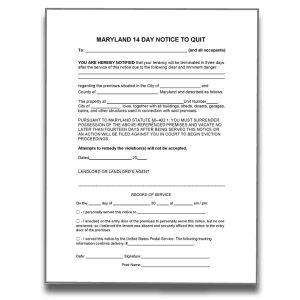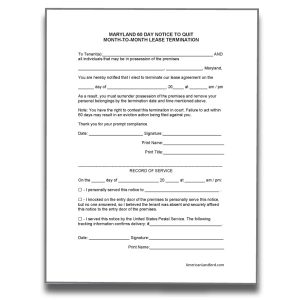Maryland Eviction Process
The information contained in this page is for residential landlords in Maryland and does not apply to commercial or agricultural property.
1. Prepare a notice to quit. Before a formal court filing can occur, a landlord needs to prepare the proper notice to terminate the tenancy:
- Maryland 10 Day Notice to Pay or Quit (for nonpayment of rent)
- Maryland 14 Day Notice to Quit (for imminent threats)
- Maryland Notice to Cure or Quit (for other lease violations)
- Maryland 60 Day Notice to Quit (for month-to-month agreements)
2. Eviction lawsuit is filed. If the tenant fails to comply with the landlord’s notice, eviction proceedings can begin by filing a complaint with the local district court.
4. Tenant is served. After the filing of all documents, a court date will be scheduled and the landlord must have the sheriff server the tenant with a copy of the complaint and summons.
5. Petition for Warrant of Restitution. If the tenant fails to show up or fails to argue an acceptable defense, the court will issue a judgment in favor of the landlord. The tenant will then have up to 4 days to move out. If the tenant is still occupying the property after 4 days, the landlord may obtain a Petition for Warrant of Restitution from the local district court which gives the sheriff the authority to remove the tenant.
Notice to Quit
A 10 Day Notice to Pay or Quit demands a tenant to pay the outstanding rent within 10 days or move out.
A 14 Day Notice to Quit is to demand a tenant move out for creating or being an imminent threat.
A Notice to Cure or Quit is to demand lease violations to be cured within 14 days or terminate within 30 days.
A 60 Day Notice to Quit is to terminate a month-to-month lease.
[/su_box]


